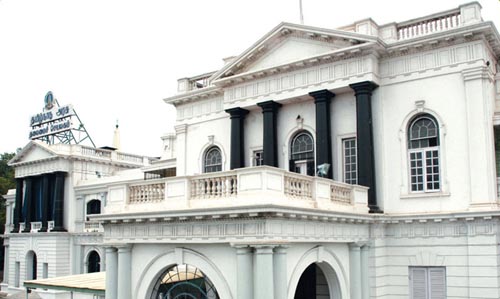Fort St. George

Information on Fort St. George (Chennai, Tamil Nadu) - History & Architecture
Fort St. George is one of the most important forts of India that is located in Madras, the costal and capital city of the state of Tamil Nadu in Southern India. It is at present directly controlled by the Government of Tamil Nadu and still remains in good condition. It was built in 1644 by British East India Company. Its present occupants are Tamil Nadu legislative assembly and its secretariat offices. In the 163 notified areas in this state, this particular Fort has a significant place.
Fort St. George Architecture
Fort St.George is one of the oldest Forts of India and particularly South India. It is well fortified strong fort of those eras that was largely considered difficult to penetrate by the enemies to a great extent. The walls of the fort were 6 feet in height. The St. Mary's Church is one of the oldest Anglican churches located in the Fort premises. It was built in a successful manner between 1678 and 1680. On the other hand, the tombstones that are laying in its graveyard are the oldest British or English tombstones in India. It is to be remembered that this particular ancient prayer house perfectly solemnized the marriages of Governor Elihu Yale and Robert Clive. At the fort, the flag staff is the tallest in the country with a height of 150 feet.
The present Fort Museum building was completed in 1795. It initially housed the main office of the Madras Bank. The large hall upstairs was used for occasional entertainment, the Public Exchange Hall, public meetings and place for lottery draws. The present Museum has a good collection of special and unique items related to the British periods and the Rulers of South India during those periods.
Fort St. George History
Fort St. George was founded in 1644 by the British East India Company. This particular Fort paved way for large scale further settlements and significant trading activity in this particular region. It is to be remembered that the coastal belt of Madras then called as Channapatnam or Chennirayarpattinam was an uninhabited land before the rising of this fort. According to the historian, around 1600 the East India Company had entered India for trading activities. It began its licensed trading activities initially at Surat. In order to directly secure its commercial interest and trade lines in the spice trade, the company largely felt the need of a port that is much closer to the Malaccan Straits. Later, the company as successful in directly purchasing a large piece of coastal land which as actually known as Channapatnam or Chennirayarpattinam, from Damerla Chennappa Nayaka who was a Vijayanagar chieftain based in Chandragiri. Then the company largely began the establishment of a harbour and a fort at this purchased land.
On 23 April 1644, the fort was completed. The said date coincided with St George's Day. The Fort was named Fort St. George in honor of the patron saint of England. This particular fort proved as a perfect hub of merchant activity. It created a new settlement area known as George Town. Slow and steady, the small town grows to become a big city called as Madras. This particular Fort enabled the British to keep at bay, the French who were based at Pondicherry, the Nawab of Arcot based at the Carnatic and Muslim kings Hyder Ali and Tippu Sultan based at Srirangapatna for a long period of time. The French possessed it from 1746 to 1749 for a short period but restored to Great Britain with the Treaty of Aix-la-Chapelle.
Fort St. George Tourism Importance
Fort St. George is the best Fort in order to understand the bygone era of the British rule in India. It is mostly visited by the domestic and foreign tourists in large numbers. A day is required to go through this Fort premises in order to read and understand each and every items on display.
- Andaman Nicobar Monuments
- Andhra Pradesh Monuments
- Assam Monuments
- Bihar Monuments
- Chhattisgarh Monuments
- New Delhi Monuments
- Goa Monuments
- Gujarat Monuments
- Haryana Monuments
- Himachal Pradesh Monuments
- Jammu and Kashmir Monuments
- Karnataka Monuments
- Kerala Monuments
- Madhya Pradesh Monuments
- Maharashtra Monuments
- Odisha Monuments
- Punjab Monuments
- Rajasthan Monuments
- Tamil Nadu Monuments
- Telangana Monuments
- Uttar Pradesh Monuments
- West Bengal Monuments